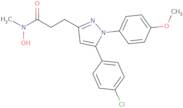Tepoxalin
CAS: 103475-41-8
Ref. 3D-DEA47541
| 5mg | Ausgelaufen | ||
| 10mg | Ausgelaufen | ||
| 25mg | Ausgelaufen | ||
| 50mg | Ausgelaufen | ||
| 100mg | Ausgelaufen |
Produktinformation
- 1H-Pyrazole-3-propanamide, 5-(4-chlorophenyl)-N-hydroxy-1-(4-methoxyphenyl)-N-methyl-
- 3-(5-(4-Chlorophenyl)-1-(4-methoxyphenyl)-3-pyrazolyl)-N-hydroxy-N-methylpropanamide
- 3-[5-(4-chlorophenyl)-1-(4-methoxyphenyl)-1H-pyrazol-3-yl]-N-hydroxy-N-methylpropanamide
- 5-(4-Chlorophenyl)-N-hydroxy-1-(4-methoxyphenyl)-N-methyl-1H-pyrazole-3-propanamide
- 5-(p-Chlorophenyl)-1-(p-methoxyphenyl)-N-methylpyrazole-3-propionohydroxamic acid
- Orf 20485
- Rwj 20485
- Tepoxalin [USAN:INN]
- Tepoxalina
- Tepoxalina [Spanish]
- Mehr Synonyme anzeigen
- Tepoxaline
- Tepoxaline [French]
- Tepoxalinum
- Tepoxalinum [Latin]
- Unii-Tz4Ox61974
- Zubrin
Tepoxalin is a nonsteroidal anti-inflammatory drug (NSAID) that inhibits prostaglandin synthesis by blocking the cyclooxygenase enzyme. It is used to treat bowel disease and autoimmune diseases, as well as for the prevention of bowel disease in patients with inflammatory bowel disease. Tepoxalin has been shown to inhibit the production of inflammatory mediators such as tumor necrosis factor-α (TNF-α), interleukin-1β (IL-1β), and nitric oxide in animal models. These effects are due to its inhibition of both COX-1 and COX-2, which are enzymes involved in the synthesis of these mediators. Tepoxalin also shows clinical efficacy in reducing pain and inflammation associated with ophthalmic disorders, such as iritis or corneal ulcers. The toxicological profile includes eye, skin, and respiratory irritation; local tissue damage; immunotoxicity; genotoxicity; carcin





